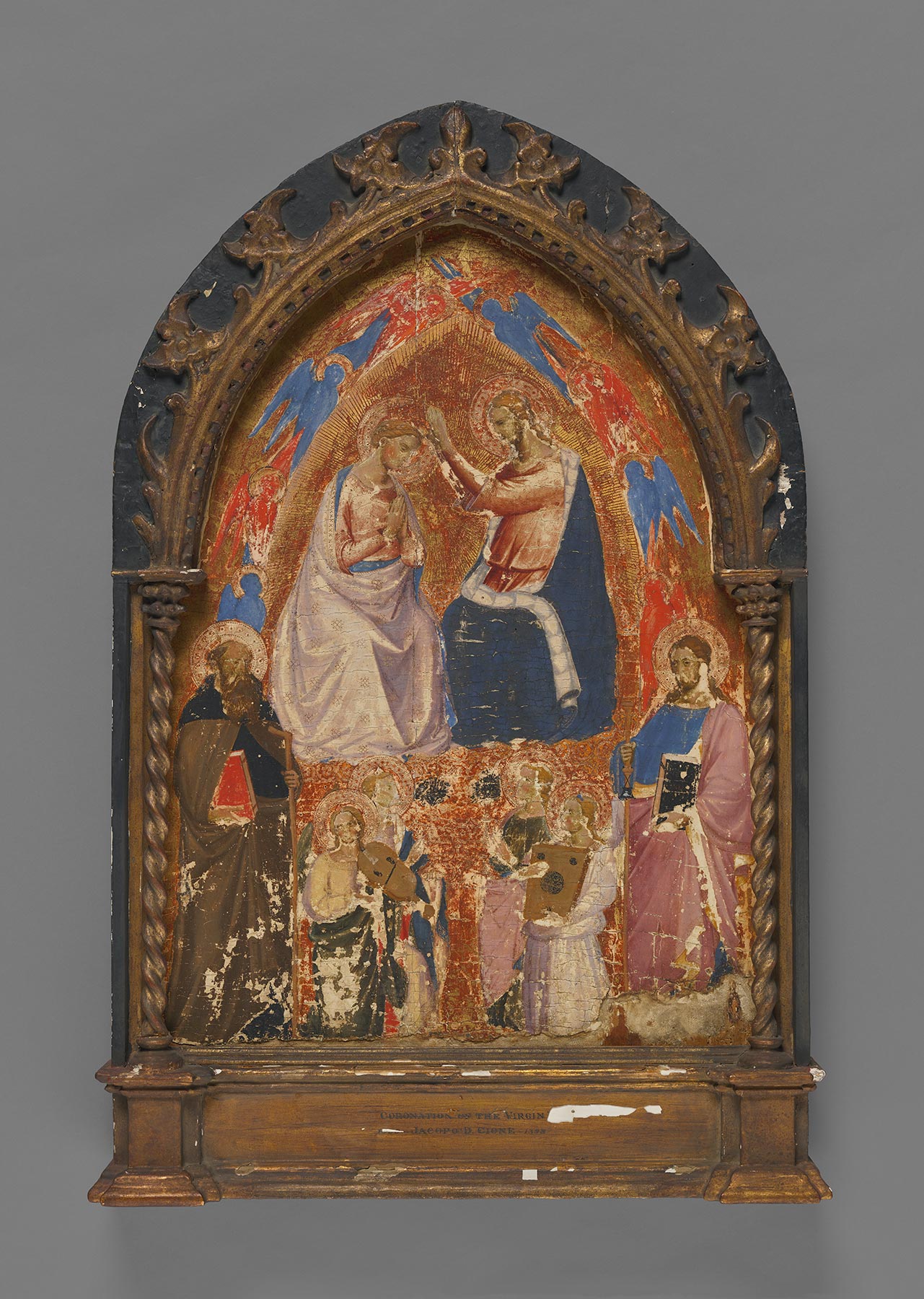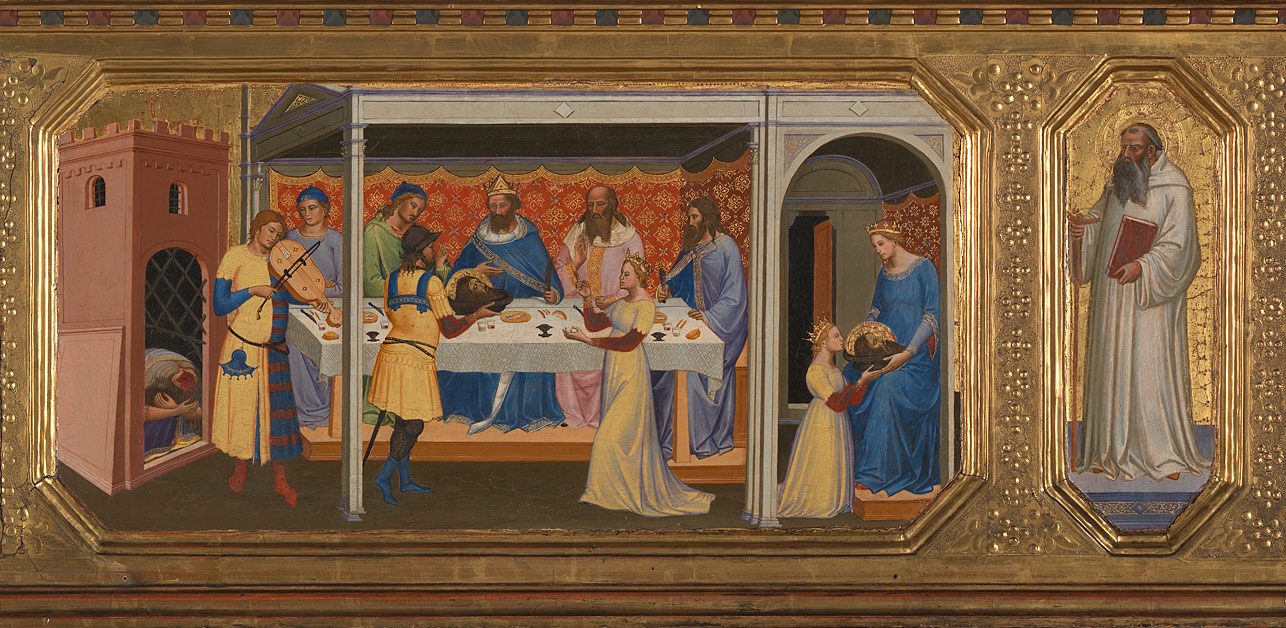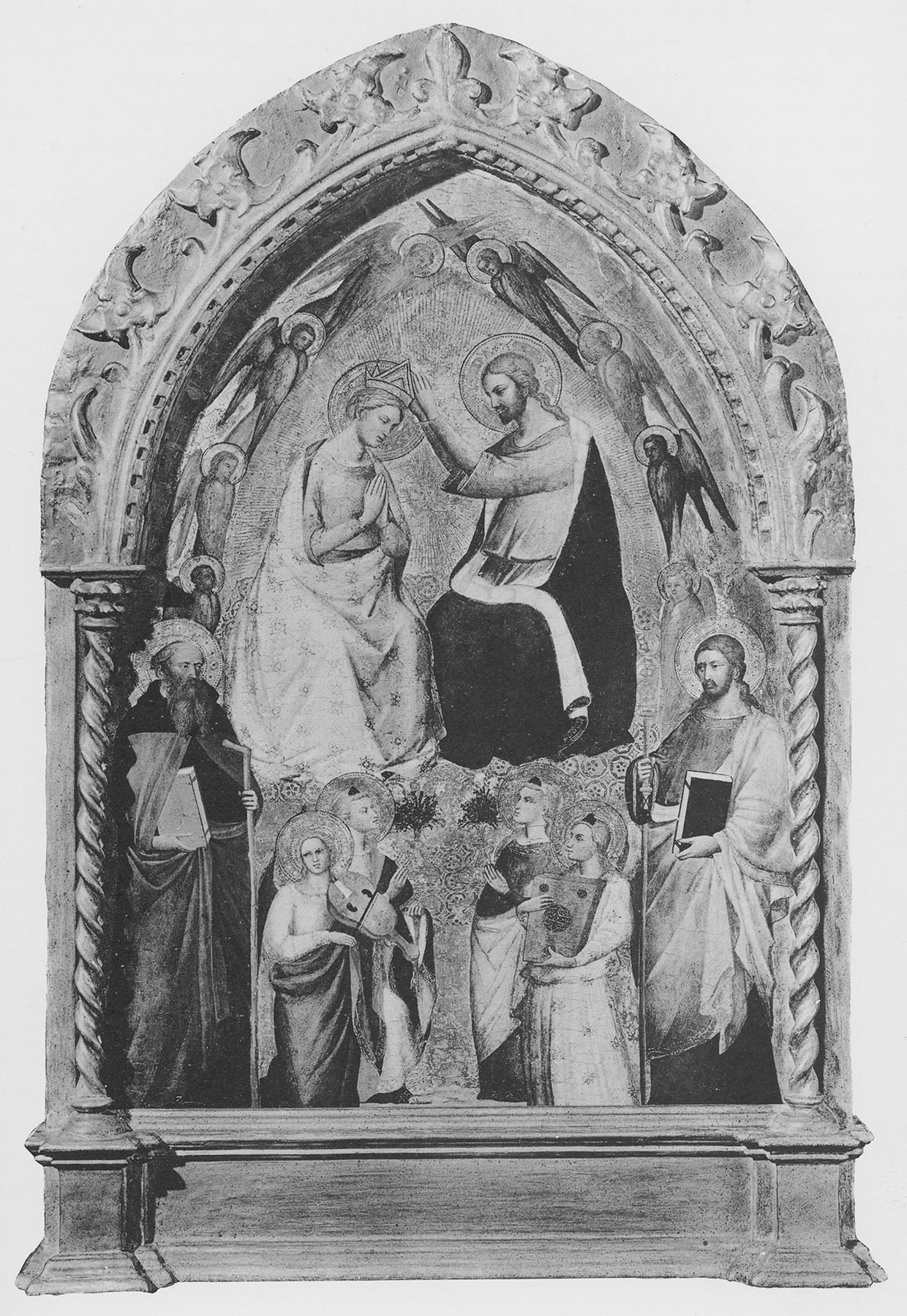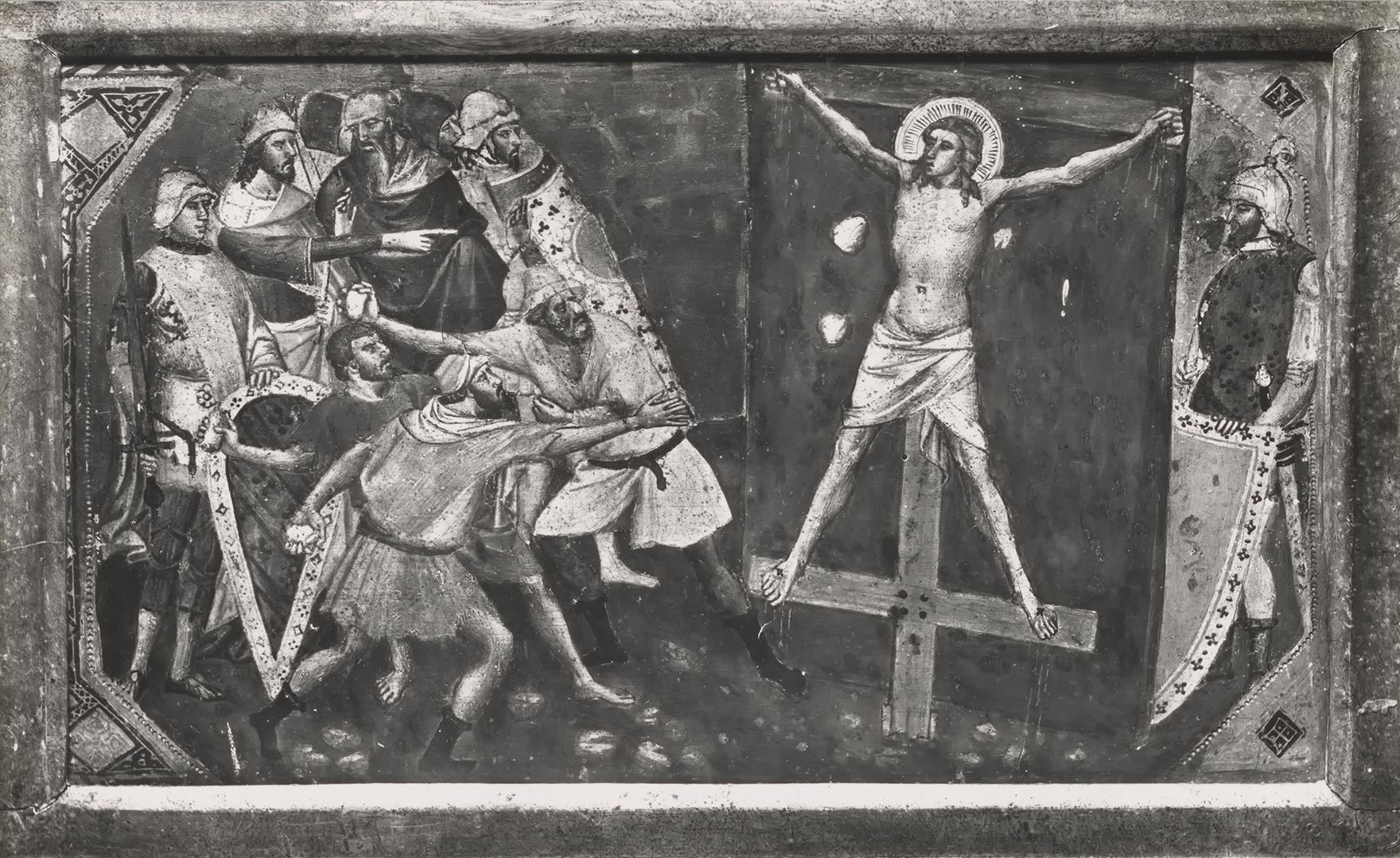Hannah D. and Louis M. Rabinowitz (1887–1957), Sands Point, Long Island, N.Y., by 1945
The panel, of a vertical wood grain, was cut out of its original frame, thinned to a depth of 1 to 1.5 millimeters, and marouflaged onto a walnut support, which was then cradled. It has been truncated at the bottom, but despite damage to the gilding and gesso along the other edges, the composition otherwise appears to be complete. A split or seam runs the full height of the panel 30 centimeters from the right edge, and a second, minor split has appeared in the upper part of the panel, 16.2 centimeters to the right of the first, apparently caused by a seam in the walnut backing board. Neither has resulted in significant paint loss or deformation of the picture surface. The gold ground is evenly abraded throughout. Orange pigment over the gold that once defined a textile covering for a low-backed throne or bench on which Christ and the Virgin are seated and which extends a short distance beneath their feet is almost entirely lost, leaving only small remnants in the sgraffito and punched decoration of the gold in that area. Similarly, yellow pigment that contrasted with the sgraffito rays of gilding defining the aureole of light around them, within the mandorla of seraphim and cherubim, is largely lost. The faces and hands of all the figures are worn to their preparatory layers. The pigments of the draperies are, by comparison, well preserved, having suffered from scattered flaking losses, exaggerated and enlarged in the 1959–60 cleaning at Yale, but they are relatively free of abrasion damages. Flaking losses are larger and more numerous near the bottom of the composition, where the craquelure is also broad and damaged from rubbing. A large total loss—exposing gesso, linen, and fragments of wood—at the lower right may have been caused by water damage.

The original tympanum of the frame, approximately 9 centimeters wide, is preserved independently of the painted panel and retains the full original thickness of the support: 3.5 centimeters (fig. 1). Its blue background has been repainted and the applied acanthus decoration regilt, but the carving is intact, and some original gilding is in evidence. A channel cut into the sight edge of the arch was meant to receive a freestanding pierced arcade of cusped moldings. The alternating red and blue decoration of the dentils on the sight edge of the arch is original. The original capitals of the framing colonettes were salvaged and reused, but the present colonettes, imposts, sides, and bottom of the frame are all modern.
The original appearance of this panel is difficult to ascertain in its present condition. The radical intervention following its transfer to Yale has affected the legibility of most of the heads of the figures and the elaborately decorated background. An impression of the painting’s former visual impact and luminous palette can be garnered from Lionello Venturi’s description of it when it was still in the Rabinowitz collection:
The Saviour and His Mother set in a mandorla and surrounded by cherubim and seraphim are seen against the radiant light of Paradise. . . . The coloring is brilliant. In spite of diversity the correspondence of tones is complete: blue is the color of the cloak of Christ and the lining of the cloak of the Madonna; the cloak of the Madonna is white embroidered with gold and blue, and so is the lining of Christ’s cloak. Both have red robes. The drapery is red and gold. The angels wear bright green, yellow, white, red and pink. St. Anthony has a black robe and cowl, though this black is somewhat highlighted by the cloak’s olive tone and the red of the book. Corresponding to St. Anthony’s black robe and cowl is the blue of the robe of St. James, but his cloak is pink with a yellow lining. His book is black. All these colors show up against the gold background, which unites them in the same way that gold unites precious stones.1
The image conforms to the “celestial” type of Coronation—with Christ and the Virgin suspended above the ground rather than seated on a clearly structured throne—that became popular in Florentine painting in the third quarter of the fourteenth century. The most notable example is Jacopo di Cione’s monumental version of 1372/73 for the Florentine Zecca,2 which provided a prototype for numerous versions on a smaller scale, painted as independent devotional panels or included in the center of small altarpieces.3 In these scenes, the heavenly sphere in which the Coronation takes place is often emphasized, as in the present instance, by a line of cherubim and seraphim arranged in a half mandorla around the figures of Christ and the Virgin, while kneeling angels and two or more standing saints occupy the level below them. In the Yale panel, two kneeling angels each hold a vase of lilies, and two others play a medieval fiddle and psaltery. Anchoring the composition are the standing figures of Saint Anthony Abbot on the left and Saint James the Greater on the right. Conceived as an independent object, the painting was originally enclosed in a tabernacle frame with a base probably containing the coats of arms of the patron(s) and possibly an inscription or other small images.
Highlighting its dependence on the models of Jacopo di Cione, Venturi published the Yale Coronation as a work of that artist. This attribution was maintained by Charles Seymour, Jr., who catalogued the panel as a product of Jacopo di Cione’s workshop with a date around 1375.4 Richard Offner was the first author to recognize a relationship between the Yale panel and the production of Niccolò di Pietro Gerini, and he included it among those images he tentatively categorized as “Gerini, Workshop.”5 The Gerini attribution was taken up by Burton B. Fredericksen and Federico Zeri and by Miklós Boskovits, who listed the Yale panel among the artist’s autograph works, placing its execution between 1385 and 1390.6 Luciano Bellosi and Carl Strehlke subsequently reiterated Boskovits’s opinion.7 Most recently, Ada Labriola, who accepted Boskovits’s chronology, included the Yale Coronation in a group of small-scale paintings that she dated in close proximity to the artist’s 1387 altarpiece with the Baptism of Christ in the National Gallery, London:8 a little-known panel with Saints Benedict, Christopher, and Catherine of Alexandria in the Lindenau-Museum Altenburg, Germany; a Virgin and Child in the Denver Art Museum; a predella with the Adoration of the Magi in the Gemäldegalerie, Staatliche Museen zu Berlin; and a predella with the Crucifixion, formerly on the art market in London.9
Notwithstanding the difficulty of judging the present state of the Yale Coronation, the Gerinesque elements of the composition and its debt to the London Baptism (fig. 2), universally assigned to the painter, remain self-evident. Beyond generic comparisons, however, the distinctions between the Yale picture and other panels on the same scale within the artist’s large and not entirely homogenous oeuvre are approximate at best. The elongated proportions of the Yale figures and the tight execution evident in pre-restoration photographs (fig. 3) can be loosely related to paintings such as the Altenburg predella, as suggested by Labriola, although the rational handling of details, such as the books held by the Yale saints, presents a marked contrast to the spatial inconsistencies of that panel, possibly indicating a more accomplished hand in the same workshop. More closely related to the Yale Coronation is the Berlin fragment, but perhaps even stronger analogies are to be found in the two predella scenes by Gerini, showing the martyrdoms of Saints James and Philip, presently inserted into the arbitrarily reconstructed polyptych on the high altar of Santa Croce, Florence (fig. 4).10 Equally comparable is a predella panel with the Crucifixion formerly in the Piero Tozzi collection, Florence, that recently reappeared on the art market in London.11 Generally dated after the London Baptism, these works represent a more advanced phase of Niccolò’s activity, in the last decade of the fourteenth century.12 —PP



Published References
Venturi, Lionello. The Rabinowitz Collection. New York: Twin Editions, 1945., 7–8, pl. 4; “Recent Gifts and Purchases: February 22–December 31, 1959.” Yale University Art Gallery Bulletin 26, no. 1 (December 1960): 52–58., 53; Seymour, Charles, Jr. The Rabinowitz Collection of European Paintings. New Haven: Yale University Art Gallery, 1961., 54; Seymour, Charles, Jr. Early Italian Paintings in the Yale University Art Gallery. New Haven: Yale University Art Gallery, 1970., 49, 308, no. 31; Fredericksen, Burton B., and Federico Zeri. Census of Pre-Nineteenth-Century Italian Paintings in North American Public Collections. Cambridge, Mass.: Harvard University Press, 1972., 81, 601; Boskovits, Miklós. Pittura fiorentina alla vigilia del Rinascimento, 1370–1400. Florence: Edam, 1975., 412; Offner, Richard. A Critical and Historical Corpus of Florentine Painting: The Fourteenth Century. Supplement: A Legacy of Attributions. Ed. Hayden B. J. Maginnis. New York: Institute of Fine Arts, New York University, 1981., 83; Ada Labriola, in Boskovits, Miklós, and Daniela Parenti, eds. Da Bernardo Daddi al Beato Angelico a Botticelli: Dipinti fiorentini del Lindenau-Museum di Altenburg. Exh. cat. Florence: Giunti, 2005., 87
Notes
-
Venturi, Lionello. The Rabinowitz Collection. New York: Twin Editions, 1945., 7–8. ↩︎
-
Galleria dell’Accademia, Florence, inv. no. 456. ↩︎
-
Offner, Richard. A Critical and Historical Corpus of Florentine Painting: The Fourteenth Century. Sec. 3, vol. 5, Master of San Martino alla Palma; Assistant of Daddi; Master of the Fabriano Altarpiece. New York: Institute of Fine Arts, New York University, 1947., 250; and Meiss, Millard. Painting in Florence and Siena after the Black Death: The Arts, Religion, and Society in the Mid-Fourteenth Century. Princeton, N.J.: Princeton University Press, 1951., 43–44. ↩︎
-
Seymour, Charles, Jr. Early Italian Paintings in the Yale University Art Gallery. New Haven: Yale University Art Gallery, 1970., 49, no. 31. ↩︎
-
Offner, Richard. A Critical and Historical Corpus of Florentine Painting: The Fourteenth Century. Supplement: A Legacy of Attributions. Ed. Hayden B. J. Maginnis. New York: Institute of Fine Arts, New York University, 1981., 83. ↩︎
-
Fredericksen, Burton B., and Federico Zeri. Census of Pre-Nineteenth-Century Italian Paintings in North American Public Collections. Cambridge, Mass.: Harvard University Press, 1972., 81, 601; and Boskovits, Miklós. Pittura fiorentina alla vigilia del Rinascimento, 1370–1400. Florence: Edam, 1975., 412. ↩︎
-
Bellosi, verbal communication, 1987; and Strehlke, unpublished checklist of Italian paintings at Yale, 1998–2000, curatorial files, Department of European Art, Yale University Art Gallery. ↩︎
-
Ada Labriola, in Boskovits, Miklós, and Daniela Parenti, eds. Da Bernardo Daddi al Beato Angelico a Botticelli: Dipinti fiorentini del Lindenau-Museum di Altenburg. Exh. cat. Florence: Giunti, 2005., 87. ↩︎
-
Lindenau-Museum Altenburg, Germany, inv. no. 64; Denver Art Museum, inv. no. 1955.109; Gemäldegalerie, Staatliche Museen zu Berlin, inv. no. 1112; and Sotheby’s, London, December 16, 1980, lot 111. The Crucifixion predella is actually not by Gerini. It last appeared at Christie’s, London, July 10, 1987, lot 98, with a more convincing attribution to Spinello Aretino, suggested by Everett Fahy. ↩︎
-
The scenes were originally located below Gerini’s Virgin and Child with Saints Philip and James, now in the main compartment of the Santa Croce high altarpiece. All three panels were in the Galleria degli Uffizi, Florence, in the eighteenth century. In 1869 they were transferred to the Opera di Santa Croce and integrated into the present monumental polyptych, arbitrarily reconstructed with fragments of various authorship and origin. Niccolò’s predella panels were placed below the figures of Saints Augustine and Gregory from a different complex by Giovanni del Biondo. See Marcucci, Luisa. Gallerie nazionali di Firenze: I dipinti toscani del secolo XIV. Cataloghi dei musei e gallerie d’Italia. Rome: Istituto Poligrafico dello Stato, 1965., 112–13, no. 71. ↩︎
-
Sotheby’s, London, July 10, 2003, lot 29. ↩︎
-
The Santa Croce predella scenes were first attributed to the artist by Richard Offner, who dated them between 1392 and 1401; see Offner, Richard. “Niccolò di Pietro Gerini, Part Two.” Art in America 9, no. 6 (October 1921): 233–40., 238. The same chronology was proposed by Marcucci, Luisa. Gallerie nazionali di Firenze: I dipinti toscani del secolo XIV. Cataloghi dei musei e gallerie d’Italia. Rome: Istituto Poligrafico dello Stato, 1965., 112. For Miklós Boskovits, in Boskovits, Miklós. Pittura fiorentina alla vigilia del Rinascimento, 1370–1400. Florence: Edam, 1975., 406, they were executed around 1395–1400. The Crucifixion was first identified by Offner as “Gerini, School” and listed as being in the Tozzi collection in 1940; see Offner, Richard. A Critical and Historical Corpus of Florentine Painting: The Fourteenth Century. Supplement: A Legacy of Attributions. Ed. Hayden B. J. Maginnis. New York: Institute of Fine Arts, New York University, 1981., 84, fig. 157. Boskovits subsequently published the panel, by then in the Drey collection, New York, among the artist’s late autograph production, between 1405 and 1410; see Boskovits, Miklós. Pittura fiorentina alla vigilia del Rinascimento, 1370–1400. Florence: Edam, 1975., 412. ↩︎